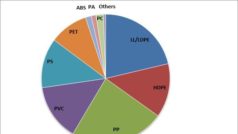Cedar Poly uses the new system as part of its recycling line for post-consumer HDPE (high-density polyethylene), which is obtained chiefly in the form of empty containers and bottles. As the company’s managing directors Jeremy and Scott Rogers confirm, the plant is now proving its worth in day-to-day operation. “With our old system we had a maximum throughput limit of 300 kg/h, and its cleaning performance was not sufficient to produce a recyclate suitable for direct further processing. After thorough investigation, we opted to purchase the most advanced technology from Europe. In Lindner washTech, we found a partner who possesses an extensive know-how in plastic recycling, prepared to design, build and install a system tailored to our needs.”
The custom-designed washing system comprises multiple stages: In a first step, the shredded HDPE flakes pass a pre-washing cycle in which the material is soaked and contaminations such as stones, metals and glass are removed. Paper label residue and other contaminants are then separated by two washTech LF 600 friction washers (560 mm rotor diameter, 3000 mm rotor length, 30 kW motor). These washing units feature replaceable paddles and screens which help cut the overall operating cost. The newly developed rotor provides highly effective cleaning due to an optimized dwell time of the material. Heavier plastic fractions such as PET, ABS or PVC are removed in a further separator stage.
The material is then sent through a washTech LMD 2000 / 1200 mechanical dryer (1200 mm rotor diameter, 2000 mm rotor length, 90 kW motor) providing a particularly ‘gentle’ drying action. The final stage is an air wash system in which any remaining fines and film particles are separated.
When the cleaned and dried HDPE flakes are subsequently filled into big bags, they have a residual moisture of less than 1 %. Despite this very low moisture level and the high supported throughput rates, the operating costs of this advanced washing system are fairly low because no thermal drying is needed and the water consumption amounts to only around 5 m³/h.








